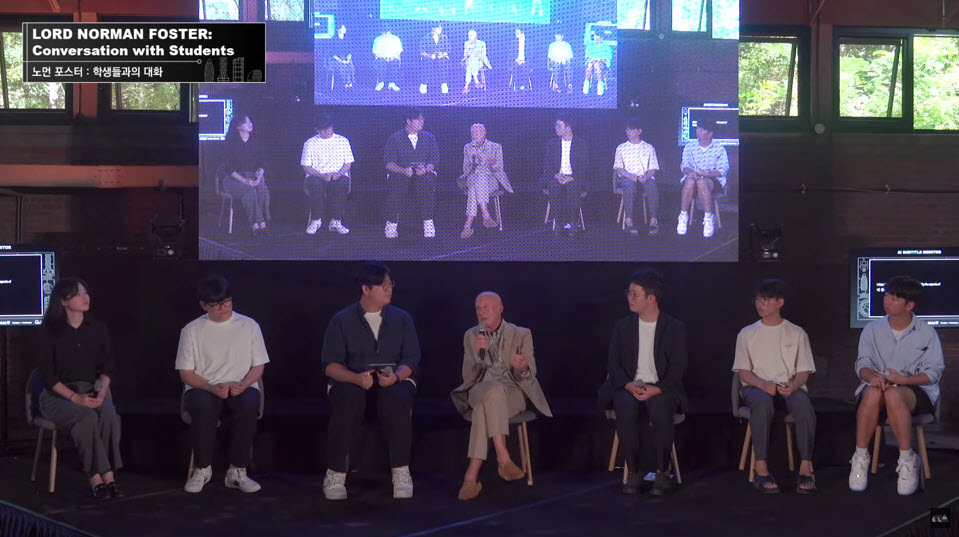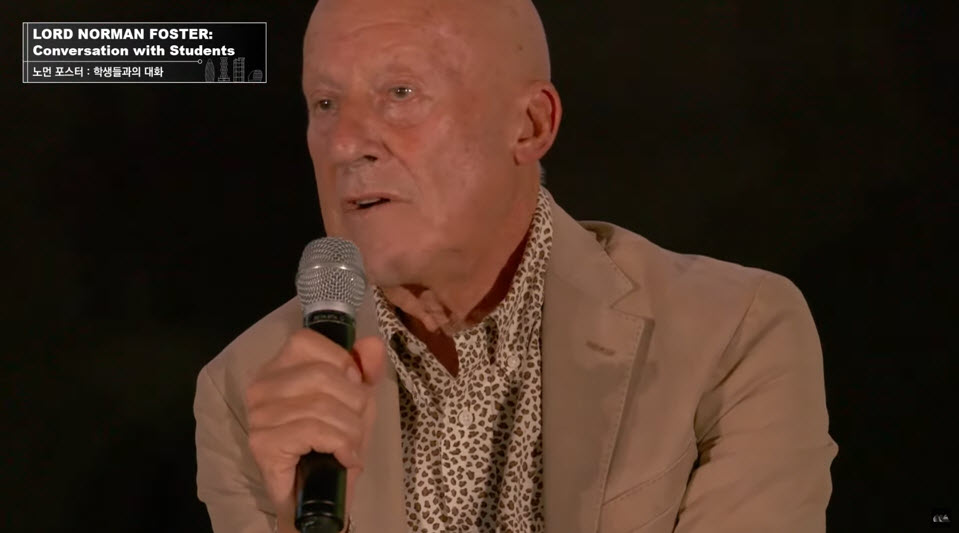On September 6, the SNU Institute for Culture and Arts hosted a conversation with architect Lord Norman Foster. The Institute was established two years ago to encourage creative engagement and partnerships and prepare for a new age of technology and cultural rapture. It hosted Foster in Building 68, which has previously been used as a powerplant but has been transformed into a creative space for the Institute’s various programs.

Lord Norman Foster: Conversation with Students (Source: SNU Institute for Culture and Arts youtube channel)
One of the most renowned figures in modern architecture, Foster is widely noted especially for what is known as his “high tech architecture style.” Over a career spanning more than 50 years, he has created structures that combine innovation with usability and beauty with sustainability. His work has transformed skylines all around the world, and his efforts at pushing the boundaries of design has brought him recognition on a global scale. Foster also founded the Madrid-based Norman Foster Foundation, which promotes interdisciplinary research and education in architecture. His talk at SNU covered a variety of subjects, including his recent exhibition at the Pompidou Center in Paris, his career as an architect, his vision for aspiring architects, and the direction of his non-profit foundation. The talk was held mainly in a question-and-answer format between Foster and students.
Sustainability: Architecture and the Future
Many of the questions touched upon the importance of sustainability in architecture. Discussing the next new wave of technology in the fourth industrial revolution, Foster stressed that sustainability in such an age comes down to the issue of energy, pointing out that, however much we might choose to live in the virtual world, we cannot escape the physicality of the real world. “We do live in the built world,” he said, and suggested that nuclear energy is, at least for now, the most realistic way of generating energy in ways that give us complete control of the waste.
Foster’s exhibit at the Pompidou featured a segment on the moon, which to many architects is a unique environment. In answer to a question about architecture in space, Foster contemplated the architect’s role in building in outer space and the ethical implications of humans potentially contaminating celestial bodies. While he admitted that the issue of preserving and regulating outer space moves into the political domain, he was favorable toward exploration in that “human spirit is about pushing boundaries.” Given a whole new environment, humans must go back in time to the birth of buildings in early civilization when architecture was essentially the act of working with materials immediately at hand. From this perspective, building in space is like discovering a new vernacular.

Foster is sharing his thoughts with students. (Source: SNU Institute for Culture and Arts youtube channel)
Connectivity: How Architecture Changes Lives
Foster presented himself to be a firm believer in the potential that architecture has of bringing us happiness and leading us to live better lives. During the event, he brought up several studies illustrating how deeply architecture can affect our lives, such as a study showing that patients recovered more quickly in hospital wards with windows. He emphasized that architectural choices are not either/or. “It’s not that if it’s functional it can’t be beautiful, or vice versa. Beauty and spirit are part of the function,” he said.
Foster considers communication within communities and architectural teams to be one of the top priorities in his design process. In response to a question about team leadership, Foster thought back to what he considered one of the greatest compliments he has received in his career – that he was a “good listener.” “It’s really important that you listen to many different voices,” he said. “The more knowledgeable you are by gathering all the voices, the better you are at making decisions.”
Education: Architecture and Beyond
Foster is known also for founding and leading the Norman Foster Foundation, a non-profit educational organization. When asked about the foundation, he introduced it as being founded upon the importance of archiving and education. Every year, the Foundation’s workshop brings together ten architectural students from around the world and matches them with ten world leading experts as mentors. The team undertakes live project work, listens to various talks from mentors, and delivers a final presentation. The focal ideas of the workshop are issues of the city and sustainability. The workshop is currently in development to expand into a one-year program, starting next January. A distinctive feature of this program will be that participants will be able to gain hands-on experience in a city setting. It will focus on three European cities for the first year but will expand to other countries and continents.
Foster also offered advice to aspiring architects. One student asked about what Foster would do as a student if he could go back in time. Noting that he was especially impressed with SNU’s architecture curriculum, Foster suggested, “I would do what you perhaps take for granted – you do two years together as students of engineering and architecture, and then you specialize in either.” He also recommended developing skills beyond architecture, whether it be business management or other kinds of art. “You’re designing for real life, which is multifaceted,” he commented. “So what advice to give someone graduating? Stay a student. Keep curious and inquire.”
Written by Minjoo Lee, SNU English Editor, mjl1018@snu.ac.kr
Edited by Professor Song Jiewuh, Department of Political Sciences and International Relations

